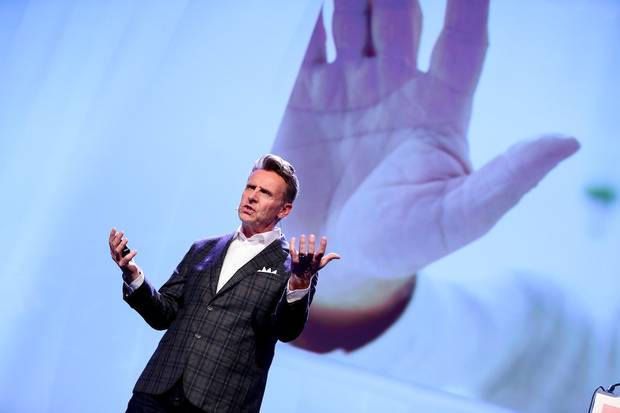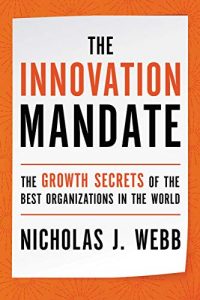The Innovation Mandate

Recently I had the opportunity to interview Nicholas Webb, a world-renowned Business Strategist, Bestselling Author and Futurist about his new book The Innovation Mandate: The Growth Secrets of the Best Organizations in the World.
As an Inventor, Nicholas invented one of the first wearable technologies, and one of the world’s smallest medical implants. He is the founding CEO of the Cravve a top Business Growth Consulting Firm. He has been awarded over 45 Patents by the US Patent and Trademark Office for a wide range of cutting-edge technologies. Nicholas is the author of The Innovation Playbook, The Digital Innovation Playbook and the Number One Bestselling Book on Customer Experience entitled, What Customers Crave. This powerful book was listed by LinkedIn as on of the top summer business book reads for 2017 and Mashable’s top marketing books for 2017.
As a Business Advisor, he works with some of the top brands to help them lead their market in Growth Strategy, Customer Experience (CX) and Innovation. Nicholas received his Doctorate of Humane Letters (hon.) from WUHS. Nicholas also serves as an Adjunct Professor of Innovation and the Director for the Center of Innovation at one of Southern California’s top medical schools WesternU. As a keynote speaker Nicholas speaks at over 50 events worldwide each year on innovation, future trends and healthcare.
Without further ado, here is the transcript of that interview:
1. Why do you think it is important for companies to think about innovation in the same way that they think about making a profit?
Organizations think about profit all of the time, in fact many organizations are obsessed with profitability. Although profit is important, it’s also a derivative of delivering meaningful value to both their enterprise and the customers they serve, and this of course is the literal definition of innovation. One of the biggest problems for organizations today is they have transitioned their focus away from the customer and innovation and are now focusing primarily on internal measurements rather than the way in which they deliver a continuous pipeline of value to the marketplace. Remember that profit is a derivative of gaining exceptional market insights that are transmuted into customer value and that’s why focusing on innovation should be a priority.
2. In your mind, what is innovation and where does it start?
I believe that there are four components to innovation and my simple definition station is “innovation is the creation of new value that serves your organization’s mission and customer.†The components include new meaning novel, this doesn’t mean new to the universe it may be a new way to apply supply chain methods to your industry that you borrow from another industry. Newness means that it’s new to your organization, market and customer. The term value speaks to a range of innovation impact which includes incremental, landmark, breakthrough and disruptive value. Needless to say, and innovation also has to serve your organization’s mission and ultimately the customers you serve. I believe the four ingredients include new, value that serves your organization and customer. I believe that all innovation begins with an honest and complete assessment of your current state of innovation readiness. Innovation is an ecosystem that has many moving parts and they must all be in good shape or you have system collapse. Once you’ve identified the gaps you can then build out a comprehensive innovation roadmap that you can deploy in a sustainable and scalable way.
 3. What is the role of insights in innovation and how do successful companies identify insights?
3. What is the role of insights in innovation and how do successful companies identify insights?
Most organizations have two problems as it relates to insights that drive their innovations. The first problem is they tried to exclusively use Voice of the Customer (VOC) and or Net Promoter Score (NPS) data. In my practice, I find that this data although good, is often times incomplete and only a fraction of what is needed to drive good decisions in the development of innovations. The second problem is they often get erroneous data through old-fashioned surveys and focus groups. The truth of the matter is, but the best organizations have multiple sources of data on what their customers truly crave when did they aggregate the data to make good decisions. I believe it’s important to look at the data across the customer journey and throughout the range of customer personas.
4. Most people will have heard of the Ten Types of Innovation from Doblin, but there are other models with just three. How do you classify innovations?
Like most of us in the innovation space, I’m a big fan of Doblin’s work. I think one could argue that there are 50 types of innovation, while still making a good argument that there are only three. After researching thousands of organizations, I discovered that it really is based on how many areas of your organization are you going to apply innovation to I believe that’s how you get to the number.
5. What is an innovation mandate and what are the keys to creating a good one?
An innovation mandate is when a Board of Directors and the CEO have made innovation and enterprise mandate and they support innovation with budgets people and resources for the long run.
6. From your perspective, why do so many innovation programs fail?
I’ve done a great deal of research in this area, and I find that the biggest innovation initiative killers are what I call the bumper sticker syndrome. This is when a CEO or some other leader decides to launch an innovation initiative, yet they have never really truly committed to the initiative in a way that would give it any chance of scalable success. For most organizations, they need to change their appetite towards risk build a robust innovation infrastructure and provide long-term funding and leadership support, without that most initiatives fail.
 7. What are some of the best ways to de-risk innovation?
7. What are some of the best ways to de-risk innovation?
Ironically, the best way to reduce the risk in the area of innovation is to stop focusing on risk. The overwhelming majority of methods that are used to evaluate the commercial viability of an innovation are completely risk-centric. Correspondingly, they filter out breakthrough innovations that could have really served the organization. Organization should also bolster their innovation initiative with multiple sources of data and use pilot and beta testing to validate assumptions.
8. Which is more important to innovation success – creativity or commitment?
I believe that commitment is far more important than creativity. In fact, you could argue that creativity is part of the problem. There are nearly 3,000 patents that are filed each week in the US patent office and yet only about 2% will ever reach commercialization. In other words, we create a lot of innovations without truly committing to the necessary innovation pipeline processes and thoughtfulness that could significantly increase the return on creativity.
9. What role should systems play in innovation?
I believe that there are ranges of systems that can significantly help the innovation process I have seen great success using enterprise social networks that deploy game mechanics for example. These systems provide competition and social engagement in a way that drives higher degrees of innovation and organizations. Additionally, the use of agile methods and project management tools also help us increase the efficiency while reducing risk and improving KPIs.
10. What are some of the keys to building and maintaining a successful innovation pipeline?
Innovation is a high-volume, low yield proposition. Having multiple sources of innovation to feed innovation funnel is critical to long-term innovation success. Great organizations use many systems including innovation safaris, customer hackathons, partner and vendor ideation, and many other tools to feed their organization with new ideas.
You can get your copy of The Innovation Mandate: The Growth Secrets of the Best Organizations in the World by clicking the link.
Image credit: Independent.ie
Wait! Before you go…
Choose how you want the latest innovation content delivered to you:
- Daily — RSS Feed — Email — Twitter — Facebook — Linkedin Today
- Weekly — Email Newsletter — Free Magazine — Linkedin Group
[author image=”https://www.disruptorleague.com/wp-content/uploads/2016/07/Braden-Kelley-70.jpg”]Braden Kelley is a Director of Innovation and Human-Centered Design at Oracle, and a popular innovation speaker and workshop facilitator. He is the author of two five-star books, Stoking Your Innovation Bonfire and Charting Change, and the creator of a revolutionary new Change Planning Toolkit™. Follow him on Linkedin and Twitter (@innovate).[/author]
NEVER MISS ANOTHER NEWSLETTER!
LATEST BLOGS
Three things you didn’t know about credit cards
Photo by Ales Nesetril on Unsplash Many of us use credit cards regularly. From using them for everyday purchases to…
Read MoreFive CV skills of a business-minded individual
Photo by Scott Graham on Unsplash The skills listed on a CV help employers quickly understand your suitability for a…
Read More


